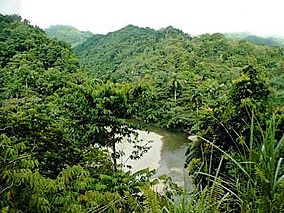Alejandro de Humboldt National Park
| Alejandro de Humboldt National Park | |
|---|---|
|
IUCN category II (national park)
|
|

Alejandro de Humboldt National Park
|
|
|
Location in Cuba
|
|
| Location | Cuba |
| Nearest city | Guantánamo |
| Coordinates | 20°27′N 75°00′W / 20.450°N 75.000°WCoordinates: 20°27′N 75°00′W / 20.450°N 75.000°W |
| Area | 711.38 km2 (274.67 sq mi) |
| Type | Natural |
| Criteria | ix, x |
| Designated | 2001 (25th session) |
| Reference no. | 839 |
| State Party | Cuba |
| Region | Latin America and the Caribbean |
Alejandro de Humboldt National Park (Spanish: Parque Nacional Alejandro de Humboldt) is a national park in the Cuban provinces of Holguín and Guantánamo. It is named after the German scientist Alexander von Humboldt who visited the island in 1800 and 1801. The park was inscribed as a UNESCO World Heritage Site in 2001 for of its size, altitude range, complex lithology, landform diversity, and wealth of endemic flora and fauna.
The rivers that flow off the peaks of the park are some of the largest in the insular Caribbean. The park is said to be the most humid place in Cuba and this causes a high biological diversity. The park has an area of 711.38 km2 (274.67 sq mi), of which 685.72 km2 (264.76 sq mi) land area and 22.63 km2 (8.74 sq mi) marine area. Elevation ranges from sea level to 1,168 m (3,832 ft) on El Toldo Peak.
16 of Cuba's 28 endemic plant species are protected in the park including such fauna as Dracaena cubensis and Podocarpus ekman. Fauna present in the park includes various species of parrots, lizards, hummingbirds, the endangered Cuban solenodon (endemic), hutia and snails.
The Alexander von Humboldt National Park has historically been an area of land little used by man, with only one archaeological site from the pre-Columbian period being known; this is located in the coastal zone of Aguas Verdes. During the eighteenth and nineteenth centuries some peripheral places were used as refuges or camps by maroons.
...
Wikipedia

